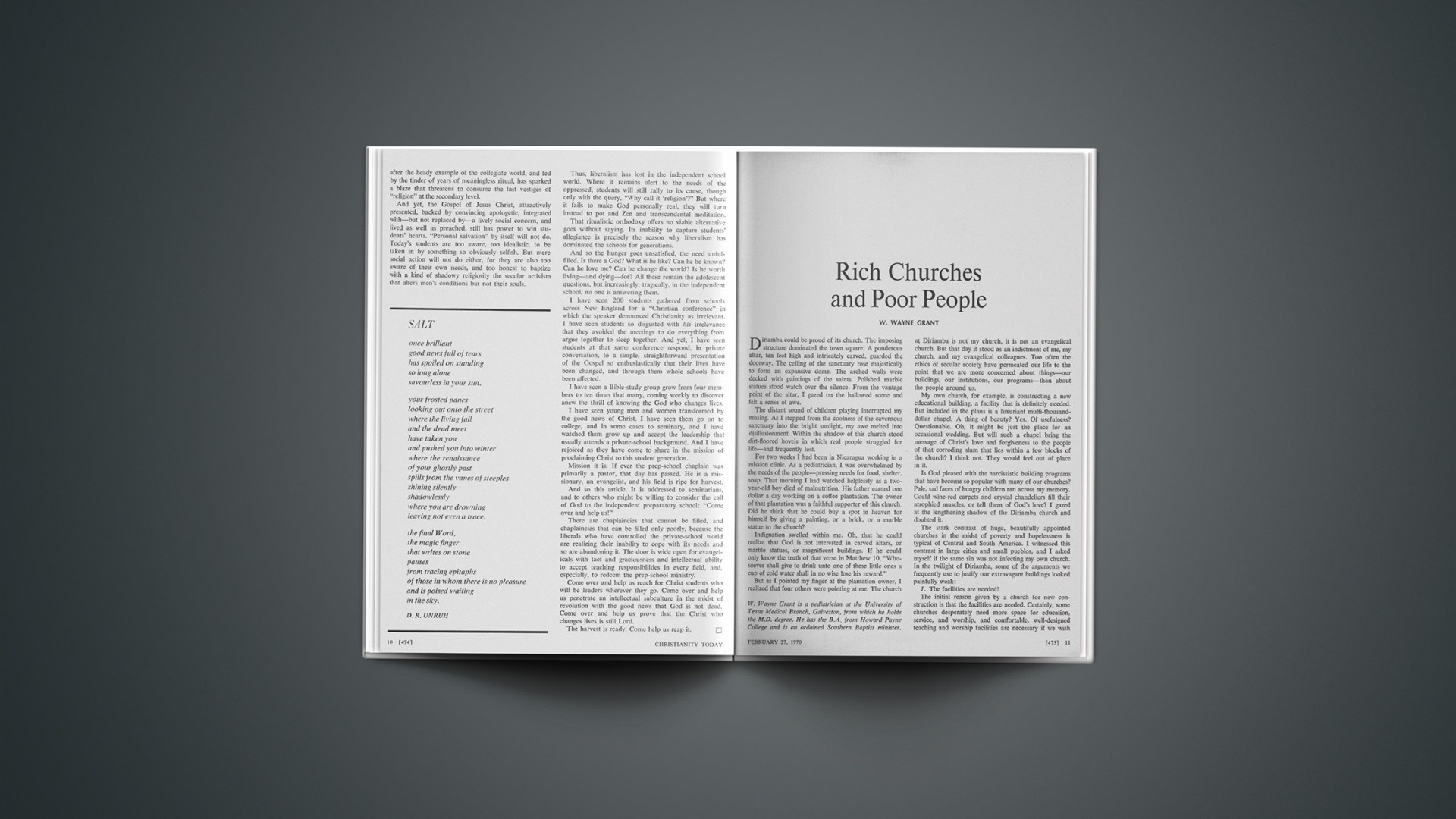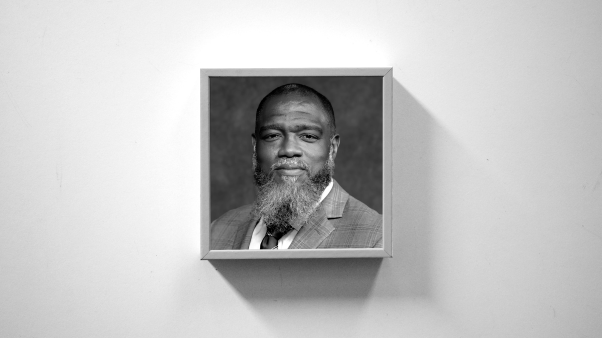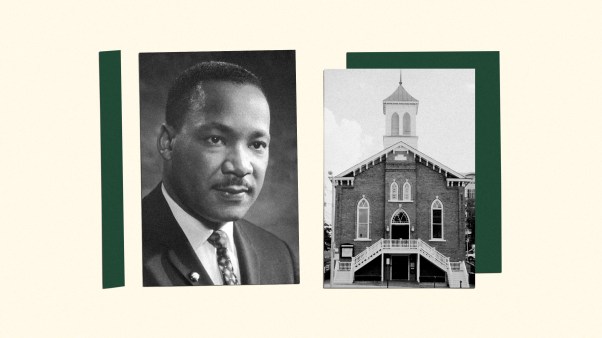Diriamba could be proud of its church. The imposing structure dominated the town square. A ponderous altar, ten feet high and intricately carved, guarded the doorway. The ceiling of the sanctuary rose majestically to form an expansive dome. The arched walls were decked with paintings of the saints. Polished marble statues stood watch over the silence. From the vantage point of the altar, I gazed on the hallowed scene and felt a sense of awe.
The distant sound of children playing interrupted my musing. As I stepped from the coolness of the cavernous sanctuary into the bright sunlight, my awe melted into disillusionment. Within the shadow of this church stood dirt-floored hovels in which real people struggled for life—and frequently lost.
For two weeks I had been in Nicaragua working in a mission clinic. As a pediatrician, I was overwhelmed by the needs of the people—pressing needs for food, shelter, soap. That morning I had watched helplessly as a two-year-old boy died of malnutrition. His father earned one dollar a day working on a coffee plantation. The owner of that plantation was a faithful supporter of this church. Did he think that he could buy a spot in heaven for himself by giving a painting, or a brick, or a marble statue to the church?
Indignation swelled within me. Oh, that he could realize that God is not interested in carved altars, or marble statues, or magnificent buildings. If he could only know the truth of that verse in Matthew 10, “Whosoever shall give to drink unto one of these little ones a cup of cold water shall in no wise lose his reward.”
But as I pointed my finger at the plantation owner, I realized that four others were pointing at me. The church at Diriamba is not my church, it is not an evangelical church. But that day it stood as an indictment of me, my church, and my evangelical colleagues. Too often the ethics of secular society have permeated our life to the point that we are more concerned about things—our buildings, our institutions, our programs—than about the people around us.
My own church, for example, is constructing a new educational building, a facility that is definitely needed. But included in the plans is a luxuriant multi-thousand-dollar chapel. A thing of beauty? Yes. Of usefulness? Questionable. Oh, it might be just the place for an occasional wedding. But will such a chapel bring the message of Christ’s love and forgiveness to the people of that corroding slum that lies within a few blocks of the church? I think not. They would feel out of place in it.
Is God pleased with the narcissistic building programs that have become so popular with many of our churches? Pale, sad faces of hungry children ran across my memory. Could wine-red carpets and crystal chandeliers fill their atrophied muscles, or tell them of God’s love? I gazed at the lengthening shadow of the Diriamba church and doubted it.
The stark contrast of huge, beautifully appointed churches in the midst of poverty and hopelessness is typical of Central and South America. I witnessed this contrast in large cities and small pueblos, and I asked myself if the same sin was not infecting my own church. In the twilight of Diriamba, some of the arguments we frequently use to justify our extravagant buildings looked painfully weak:
1. The facilities are needed!
The initial reason given by a church for new construction is that the facilities are needed. Certainly, some churches desperately need more space for education, service, and worship, and comfortable, well-designed teaching and worship facilities are necessary if we wish to reach those of our own society. But I question the appropriateness of plush carpets, chandeliers, and fancy furniture. Inappropriate luxury turns off more non-Christians than it attracts. We who live in the comfort of the United States should weigh our concept of need against the harsh realities our fellow evangelicals are facing around the world.
2. God loves beauty and is honored by it!
Yes, but does he not love the beauty of an innocent child more than a massive, carved altar? Does he not love the beauty of an act of love more than a well-polished pew? A building does not have to be complex to be beautiful in the eyes of God, or man. In Diriamba, I looked at a statue of the child Christ that was laden with expensive ornaments. Then I walked outside and looked upon the faces of hungry children and wondered whether Christ, in view of that hunger, was enjoying those jewels.
Should we not ask ourselves the same question about our own jewels?
3. Beauty makes for worship!
Yes, but what kind of beauty? One of the most worshipful experiences of my life took place in a crumbling stone store in Catarina, Nicaragua, that had been converted into an evangelical church. A self-educated banana farmer preached in Spanish. I could understand only a fraction of what he said, but beauty was in his eyes and joy rang out through the congregation as they sang “Onward, Christian Soldiers.” Today Billy Graham calls thousands to accept Jesus’ love, not in luxurious churches but in football stadiums and city auditoriums. Beauty is there in the message and the Spirit of God. I have sat through many dry sermons in beautiful sanctuaries and fought to keep alert. Singing voices were lost in the high ceiling, and the words of the message were lost in expressionless faces. The beauty of fellowship, the beauty of a Spirit-filled messenger, is the beauty that induces worship. Certainly in God’s house, beauty can and should exist without extravagance, without pompous exhibitionism.
4. The money was donated for that purpose!
This lame excuse is the weakest of all, but is often heard. Members of one church excused the presence of a ponderous chandelier inappropriately dwarfing their lobby because it was donated by a dear old, and wealthy, patron. Should not a church take the responsibility of instructing its members as to what gifts are appropriate? If a proffered object will not contribute to the overall ministry of the church, should it not be gracefully rejected? We need to learn to put our resources where they will do the most good for the gospel ministry: into services for people, not into structures for posterity. (Posterity does not treasure our treasures as much as we do, anyway. Note the great number of stately sanctuaries standing empty in the inner cities, waiting to be sacrificed on the rubble heap of progress.)
Today the Church is bracing against an onslaught of criticism from secular sources over its huge investment in real estate. To some extent we may have brought this criticism upon ourselves. Too often, maybe, the Church has appeared to be a rich old lady hoarding her wealth in stately museums rather than the servant God intended it to be.
Today, should not we evangelicals fear, not so much what the secular government thinks of us, but rather what our Lord knows of us?
UNCUT STONE
Exodus 20:25
Taking up images
from speech,
untooled, to build
a base for fire
and sacrifice;
taking up
from where they’ve stuck
bits of space,
time, thing, to draw
them together into
the temple of
this present Presence.
Praise Him
with the music
of hair,
of skin & bone, the song
born as body rises
above itself;
& with the music
of children, wife,
friend;
of colors assembled,
of unhewn words;
praise Him when
Standing,
sitting, lying down: each present
in that Presence consumed.
F. EUGENE WARREN










